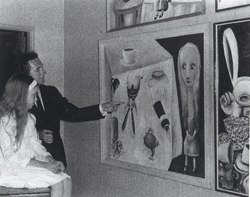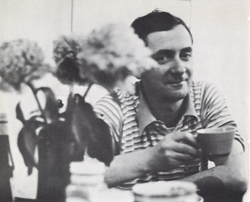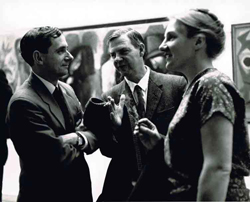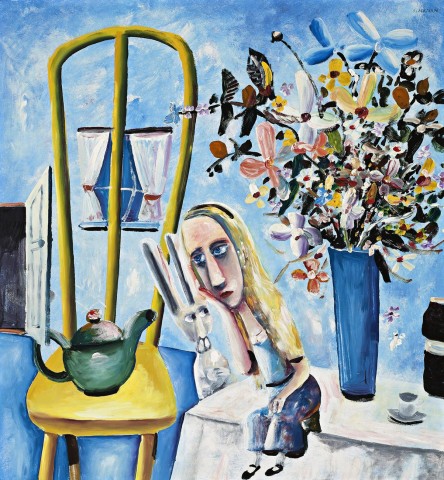ALICE ON THE TABLE, 1956
CHARLES BLACKMAN
tempera and oil on composition board
120.5 x 111.5 cm
signed upper right: BLACKMAN
Johnstone Gallery, Brisbane
Alan Waldron, Brisbane, acquired from the above in 1957
Private collection, Brisbane, acquired from the above in March 1964
Christie’s, Melbourne, 1 August 1995, lot 44
Private collection, United Kingdom
Probably: Paintings from Alice in Wonderland, Gallery of Contemporary Art, Melbourne, 12 – 22 February 1957
Charles Blackman, Johnstone Gallery, Brisbane, 19 June – 1 July 1957, cat. 6 (as ‘Alice in Wonderland’)
The Alan Waldron Collection, Johnstone Gallery, Brisbane, 9 – 17 June 1964, cat. 5
‘Alice in Wonderland’ by Charles Blackman, Johnstone Gallery, Brisbane, 4 – 21 September 1966, cat. 20
‘Alice in Wonderland’ by Charles Blackman, South Yarra Gallery, Melbourne, 21 – 30 March 1967, cat. 6
Charles Blackman: ‘Alice in Wonderland’, David Jones’ Art Gallery, Sydney, 14 – 26 October 1968, cat. 6
Mathew, R., Charles Blackman, Georgian House, Melbourne, 1965, p. 14 (as ‘Alice sitting on the table’)
Shapcott, T., The Art of Charles Blackman, Andre Deutsch, London, 1989, cat. 64, pp. 132 (illus.), 252
Stewart, K., ‘What’s On’, The Age, Melbourne, 30 July 1995, p. 42 (illus.)
Overington, C., ‘Whiteley Nude May Set Record Price’, The Age, Melbourne, 31 July 1995, p. 7
Maslen, G., ‘Misconceptions about Death and the Painter’, The Age, Melbourne, 14 August 1995, p. 24
Malsen, G., ‘Big Spenders Return to the Auctions’, The Age, Melbourne, 25 August 1995, p. 16
Smith, G., and Moore, F. St. J., Charles Blackman: Alice in Wonderland, National Gallery of Victoria, Melbourne, 2006, pp. 27, 28, 74, 75 (illus.), 136 , pp. 27, 28, 74, 75 (illus.), 136
Down, down, down. Would the fall never come to an end? ‘I wonder how many miles I’ve fallen by this time?’ she said aloud. ‘I must be getting somewhere near the centre of the earth. Let me see: that would be four thousand miles down, I think’ … ‘I wonder if I shall fall right through the earth! How funny it’ll seem to come out among people that walk with their heads downwards! The Antipathies, I think’ – she was rather glad there was no one listening, this time, as it didn’t sound at all the right word – ‘but I shall have to ask them what the name of the country is, you know. Please, Ma’am, is this New Zealand or Australia?’1
In 1956, when Charles Blackman first encountered Lewis Carroll’s beloved children’s book, Alice’s Adventures in Wonderland (1865), he was not a child but rather, a couple of years shy of his thirtieth birthday, a grown, married man who was soon to become a father. Blackman’s introduction to Carroll’s absurdist tale of fantasy and adventure – which begins with Alice following the White Rabbit down the rabbit-hole – was through a talking book which his wife, Barbara, who was legally blind, had borrowed from the library. Blackman had grown up in a house devoid of books and while he had heard of the famous story, he had never read it.2 Nor, significantly, had he seen illustrations of it, either by John Tenniel, the English artist whose drawings accompanied the first publication of the book, or any of those published subsequently.
Blackman listened to the story repeatedly and later recalled:
‘I was absolutely thrilled to bits with it … and it seemed to sum up for me at that particular moment my feelings towards surrealism, and that anything could happen. The cup could lift off the table by itself, the teapot would … pour its own tea … The world is a magical and very possible place for all one’s dreams and feelings. One is completely outside of reality … This was sparked completely off by Barbara’s influence on my life.’3
Blackman attended evening classes at the East Sydney Technical School while working as a copy boy at the Sydney Sun during the early 1940s and later, promoted to art cadet, undertook a handful of painting classes with Hayward Veal at the Meldrum School of Painting which constituted his only formal art training. From 1946-47 he participated in life drawing classes at the Society of Realist Art and it was at this time that Blackman met Lois Hunter, an avant-garde poet from New Zealand who introduced him to modern art and literature.4 Blackman followed Hunter to Brisbane in 1948 and with his mind opened to the possibilities of the creative life, befriended local artists and writers, including Barbara (née Patterson) and Barrett Reid, both members of the local Barjai group of poets. Blackman and Barbara moved to Melbourne, attracted to the city’s community of like-minded painters, writers and thinkers, and were married in 1951. Blackman conceded that ‘it wasn’t until Barbara and I were actually living together that I really started painting pictures’5 and during the following twenty years of marriage their relationship provided a solid and nurturing foundation for family, friendship and sustained creativity. Their life together was an ongoing collaboration, Barbara’s literary focus merging with and inspiring Charles’s visual creations, and Charles’ vision providing Barbara with a window onto the world: as Cynthia Nolan described them, ‘not so much two people as the two halves of a double person’.6
Blackman and Christabel_1968_ David Jones Galley.jpg

14 – 26 October 1968
Barbara’s pension for the sight-impaired and work as a life model allowed Blackman the freedom to paint full time, but this was curtailed by her first pregnancy in 1956, prompting him to find employment as a cook at the Eastbourne Café (better known in its later incarnation as Balzac restaurant) in Wellington Parade, East Melbourne. The café was run by his friend, Georges Mora, who had bought it earlier that year in anticipation of the crowds that the Olympic Games, centred at the nearby Melbourne Cricket Ground, would bring.7 A European émigré who had arrived from Paris five years earlier, Mora and his beautiful young wife Mirka, soon became what Barbara later described as the ‘vortex of our marvellous lives’, their apartment in Grosvenor Chambers at the ‘Paris End’ of Collins Street being a ‘centre of gravity (and much levity), the place of exhibitions, meetings, parties, dramatic moments, tableaux vivants, plots, confrontations, improvisations, last suppers, diagnoses and prognostications, exhibition after exhibition’.8 The café was busy and according to Blackman his efforts, ‘used to be referred to as the kitchen ballet. I used to leap from fridge to plate … my record was serving a hundred and four meals, three courses, absolutely fully served, of – not haute cuisine, but not bad food – in under two hours’.9 It was while he was working here that Blackman began to draw the images that formed the basis of his Alice in Wonderland series, the chairs, tables, teapots and crockery that surrounded him in the café becoming key motifs in the paintings. As he recalled, ‘I went to work … at 5pm … and … finished at 12 and then came home and my head was full of spinning plates and teacups and Barbara would say I brought the rabbit into the restaurant at night and it would help me do the work, and next day I would paint it all. The restaurant came into the paintings’.10
There were other influences at work too. In late June 1956 Sidney Nolan exhibited his now iconic series of paintings about the infamous nineteenth-century bushranger, Ned Kelly, and Blackman attended the opening at the new Gallery of Contemporary Art in Tavistock Place, Melbourne. Barrett Reid had first introduced Nolan to Blackman in Brisbane in 1947 and they connected again in Melbourne through John and Sunday Reed whose home, Heide, was a cultural refuge for many of the most avant-garde artists, writers and thinkers of the day. Blackman had been impressed by Nolan’s art, identifying with his ability to ‘[trap] inner feeling in the paint’ and they also shared a mutual passion for the French symbolist poet Arthur Rimbaud. While Blackman had already begun the Alice paintings, seeing Nolan’s Kelly exhibition inspired him to develop them into a major series. The image of Ned Kelly and, in particular, his stylised black mask, became a touchstone within Nolan’s oeuvre (as well as a symbol of personal significance) and he returned to the subject repeatedly throughout his career. In a similar way, the White Rabbit – mischievous, masculine and playful, an anthropomorphised representation of the artist himself – became a recurring motif in Blackman’s later work.11
Portrait of a Young Charles Blackman.jpg

Nolan also incorporated references to his own life into the Kelly paintings and this, in particular, struck a chord with Blackman. Eloquently describing Alice as ‘moving enquiringly, questioningly, trustfully, bemusedly, changefully, into a new and strange world, trying with good sense and honesty to get her bearings in it, however often she seemed to change body shape and whereabouts’12, Barbara might just as well have been writing about her own experience of pregnancy, adapting to a new and ever-changing physical form. It was this miraculous process of transformation that Blackman related to Alice’s fantastic experiences, as well as Barbara’s increasing blindness and the spatial disorientation this caused. In addition to these very personal connections, as Felicity St John Moore has documented, the series also incorporates symbolic references to Nolan and the Reeds, the Boyd home at Open Country, Murrumbeena, as well as pictorial allusions to contemporary artworld politics, including Max Meldrum’s tonalist doctrine and the battles that were being played out within the Contemporary Art Society at the time.13 Add to this the couple’s interest in Surrealism and appreciation of the absurd and irrational, combined with various everyday items that Blackman appropriated for his compositions – such as a blue and white chequered tablecloth received as a wedding present that became the chess board in The Game of Chess, 1956 (private collection) – and all of the ingredients for what would become one of the most renowned series of paintings in modern Australian art were in place.
Blackman credited the vibrant colour of the Alice in Wonderland paintings to the experience of painting outdoors with his friend, the artist John Perceval. Working in tempera (often made using eggs from the chickens at Heide) and oil paint, he also acknowledged the influence of Perceval in his approach to making these works, describing them as ‘probably the freest pictures that I’ve painted … I’m not talking about the images, I’m talking about the actual way of painting. He was a wonderfully ecstatic painter, John Perceval, very free and very beautiful … I would have the experience of watching John and … It’s as if I adopted part of his nature, and this helped … by making the form reflect my inner feelings’.14
Blackman continued painting Alice pictures into early 1957 and they were launched at his exhibition, Paintings from Alice in Wonderland, which opened at the Gallery of Contemporary Art in mid-February. At the end of the brief ten-day showing, five paintings had been sold – three to John and Sunday Reed (now all in the collection of Heide Museum of Modern Art), one to art critic Clive Turnbull and another to artist and friend, Rosemary Ryan. The exhibition was far from a commercial success and while it did attract considerable comment in the newspapers, Arnold Shore was the most enthusiastic, writing that ‘Salient incidents … are freely interpreted and the artist’s purpose is to suggest the magical topsy-turvy world which the heroine met in her journey through wonderland. Thus teapots pour of their own volition and bottles of ink fly through the air as the artist seeks to convey the humour of the Mad Hatter’s tea party. Although the humour is not as subtle and delicate as in the printed version, it is certainly amusing in a boisterous, but lyrical, way’.15
b b .jpg

Later, in June that year, a solo exhibition of Blackman’s work was mounted at the Johnstone Gallery in Brisbane which included three paintings from the Alice in Wonderland series, all of which sold to local collectors.16 This trio included The Blue Alice, 1956, eventually acquired by the Queensland Art Gallery in 2000, and Alice on the Table, 1956, priced at 50 guineas, which was bought by Alan Waldron. A luminous picture that glows in its striking emphasis on the interplay of yellow, blue and white, Alice on the Table contains all the hallmarks of a quintessential Alice painting. Wearing a blue dress with white collar and black trim, a golden-haired Alice is centrally placed and seated on a table. Depicted in a reflective pose, her head resting on her hand, she is seemingly unaware of the White Rabbit, ears erect and dark eyes staring, half visible beside her and adopting an identical sideways lean. This physical mirroring of the rabbit and Alice symbolises the intimate relationship between Charles and Barbara, the rabbit’s watchful curiosity a reflection perhaps, of the husband’s fascination with his wife’s gestational metamorphosis. Alice’s figure has evidently shrunk and she is dwarfed by the vivid yellow chair and green teapot on the left and the large blue vase of mixed flowers to the right. The lyrical depiction of these flowers recalls John Perceval’s expressive application of paint, and Blackman’s pure delight in their varied form, texture and colour is on clear display. It is impossible not to relate the flowers, bursting with life and possibility, to the impending birth of the Blackmans’ first child and to think of the paintings of female faces with flowers that emerged soon after. Possibility and promise are also suggested by the open door at the far left of the image which beckons Alice from her indoor world.
With examples now represented in major private and public collections across the country, including the National Gallery of Australia, National Gallery of Victoria, Queensland Art Gallery/Gallery of Modern Art and Art Gallery of Western Australia, the Alice in Wonderland series represented a significant turning point in Blackman’s career. Alice was a subject that, in his words, ‘allowed me to paint in a totally different style. [To believe] that anything is allowable’.17 As his own life flourished, so did his art and his imaginative depiction of Barbara as Alice ‘[released] in Blackman the artist the imaginative capacity to explore freely, without the worry of strict realism or logic, that world of experience, of feeling, which exists in all of us’18, a capacity which would ultimately see him hailed as ‘the outstanding artist of the feminine psyche’.
1. Carroll, L., Alice’s Adventures in Wonderland: Illustrated by Charles Blackman, (ed.) Amadio, N., A. H. & A. W. Reed, Sydney, 1982, p. 14
2. St John Moore, F., ‘Conception to Birth: The Alice in Wonderland Series’ in St John Moore, F. & Smith, G., Charles Blackman: Alice in Wonderland (exhibition catalogue), National Gallery of Victoria, Melbourne, 2006, p. 10
3. The artist interviewed by Robert Peach, Sunday Night Radio Two, ABC Radio, 9 September 1973 quoted in ibid.
4. For detailed biographical information see St John Moore, Charles Blackman: Schoolgirls and Angels (exhibition catalogue), National Gallery of Victoria, Melbourne, 1993, pp. 15 – 29
5. The artist quoted in Shapcott, T., Focus on Charles Blackman, University of Queensland Press, Brisbane, 1967, p. 13
6. St John Moore, 2006, op. cit., p. 13
7. See Harding, L. & Morgan, K., Modern Love: The Lives of John & Sunday Reed, The Miegunyah Press, Carlton, 2015, p. 252
8. Blackman, B., Glass After Glass: Autobiographical Reflections, Penguin, Melbourne, 1997, p. 172
9. St John Moore, 2006, op. cit., p. 11
10. The artist quoted in Shapcott, T., The Art of Charles Blackman, Andre Deutsch, London, 1989, p. 23
11. Ibid., p. 26. In addition to illustrating a 1982 publication of Lewis Carroll’s story with a selection of the Alice paintings and some new watercolours and drawings (see footnote 1), Blackman was commissioned to design the program and sets for Alice in Wonderland, a ballet performed in Perth in 1984.
12. Blackman, B. quoted in St John Moore, 1993, op. cit., p. 4
13. See St John Moore, 2006, op. cit., p. 16
14. The artist quoted in Shapcott, 1989, op. cit., pp. 23 – 24
15. Shore, A., ‘Painter in Alice’s Wonderland’, Age, Melbourne, 12 February 1957, p. 2
16. No conclusive documentation of the Melbourne exhibition remains, however it is likely that Alice on the Table, 1956 was included. See Smith, G., ‘Which Way, Which Way? The Production and Reception of Alice in Wonderland’ in St John Moore, F. & Smith, G., op. cit., p. 27
17. Amadio, N., Charles Blackman: The Lost Domains, A. H. & A. W. Reed, Sydney, 1980, p. 25
18. Shapcott, 1967, op. cit., p. 30
KIRSTY GRANT
